Ventspils
| Ventspils | |||
|---|---|---|---|
| Town | |||
|
Ventspils Castle, built by the Livonian Order, and converted into a prison in 1832. | |||
| |||
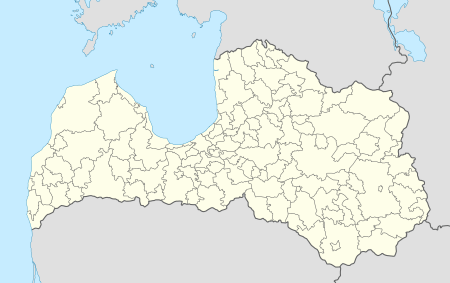 Ventspils Location in Latvia | |||
| Coordinates: 57°23′26″N 21°34′24″E / 57.39056°N 21.57333°E | |||
| Country |
| ||
| Town rights | 1378 | ||
| Government | |||
| • Mayor | Aivars Lembergs | ||
| Area | |||
| • Total | 55.4 km2 (21.4 sq mi) | ||
| Population (1 January 2012)[1] | |||
| • Total | 41,998 | ||
| • Density | 760/km2 (2,000/sq mi) | ||
| Time zone | EET (UTC+2) | ||
| • Summer (DST) | EEST (UTC+3) | ||
| Postal code | LV-36(01-21) | ||
| Calling code | (+371) 636 | ||
| Number of city council members | 13 | ||
| Website |
www | ||
Ventspils (Latvian: [ˈvæntspils]; German: Windau; Polish: Windawa; Livonian: Vǟnta) is a town in northwestern Latvia in the historical Courland region of Latvia, and is the sixth largest city in the country. At the beginning of 2012, Ventspils had a population of 41,998. It is situated on the Venta River and the Baltic Sea, and has an ice-free port. The city's name literally means "castle on the Venta", referring to the Livonian Order's castle built alongside the Venta River. Ventspils holds the national record for the highest temperature ever recorded in Latvia with 37.8 °C (100.0 °F) on 4 August 2014.[2]
History
Ventspils developed around the Livonian Order Ventspils Castle, built along the Venta River. It was chartered in 1314 and became an important mercantile city of the Hanseatic League.
As part of the Duchy of Courland, Ventspils blossomed as a shipbuilding centre. 44 warships and 79 trading ships were built in the town, and it was from Ventspils that the Duke's fleet set out to colonize Gambia and Tobago. Metal, amber, and wood-working shops also became important to the city's development.
During the Polish-Swedish War and the Great Northern War, Ventspils was destroyed, and in 1711 a plague wiped out most of the remaining inhabitants. Ventspils fell under the control of Imperial Russia and its re-growth was stalled.
It was not until about 1850 that shipbuilding and trade became important again. The port was modernized in the 1890s and connected to Moscow by rail. It became one of Imperial Russia's most profitable ports, by 1913 turning a yearly profit of 130 million rubles. The population soared as well, growing from 7,000 in 1897, to 29,000 in 1913.
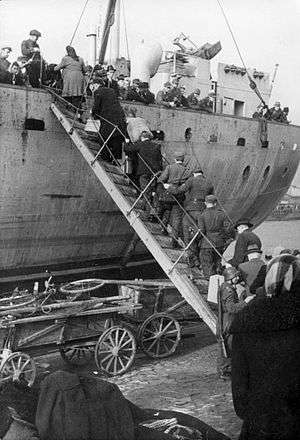
During the German occupation from 1915–1919, the population decreased almost by half, though some returned home during the First Republic of Latvia (1918–1940).
In 1939, the Red Army established a base in Ventspils. Under Soviet rule, an oil pipeline was built to Ventspils, and became the USSR's leading port in crude oil export. thirty kilometres (19 miles) north of Ventspils is the ex-Soviet radioastronomy installation VIRAC (Ventspils Starptautiskais radioastronomijas centrs or Ventspils International Radio Astronomy Centre). The existence of the Centrs was unknown to most Latvians until 1994. After independence, the Latvian government began a city-beautification process to make the city more attractive to tourists.
In 2004, Ventspils was a host city for a multi-national (United States, United Kingdom, Poland, Sweden, Russia, Latvia, Denmark, Finland, Norway) naval exercise called Baltic Operations XXXIII (BALTOPS). The force was led by the guided missile cruiser USS Anzio and the destroyer USS Cole. The US vessels were the first American warships to visit the port of Ventspils since Latvian independence was declared.
Demography
At the beginning of 2011, Ventspils had an official population of 42, 509 (54.3% of them were women compared with 45.7% men).
66% of Ventspils population (28,200 people) are 15–62 years old, 13.9% (5,949 people) are 0–14 years old, and 20.1% (8,585 people) are 62 years and over.
Population of Ventspils according to ethnic group:
| Ethnic groups | Per cent of total population |
|---|---|
| Latvians | 63.9 |
| Russians | 20.0 |
| Ukrainians | 4.7 |
| Belorussians | 4.5 |
| Poles | 1.1 |
| Lithuanians | 0.9 |
| Others | 4.9 |
Education
Institutions of higher education and science include:
- Ventspils University College
- Riga Technical University, Ventspils branch
- Riga Teacher Training and Educational Management Academy, Ventspils branch
- College of Law, Ventspils branch
Economy
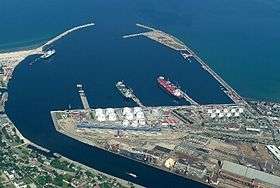
Ventspils is situated at the mouth of the Venta River, where it empties into the Baltic Sea, and is an important ice-free port. Large amounts of oil and other mineral resources from Russia are loaded aboard ships at Ventspils. The revenue from port services has made Ventspils the wealthiest city in Latvia. Ventspils Airport, one of the three international airports in Latvia, is located in the city. Ventspils High Technology Park provides infrastructure and services to IT and electronics companies.
Culture
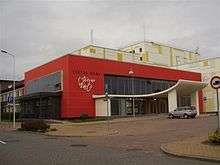
Every winter Ventspils hosts the awarding ceremony of the Latvian Radio broadcast Musical Bank and the televised national selection for the Eurovision Song Contest. On the second weekend of July the Sea Festival takes place, and on the first weekend of August there is an annual city festival.
There are several institutions taking responsibility for the cultural life of Ventspils, including:
- The Theatre House "Juras varti" presents professional performing arts of various genres.
- The Ventspils Museum is engaged in the research and the recording of the history of Ventspils. It writes the Ventspils City Chronicle, builds up the collections of the museum and carries out scientific work.
- The Ventspils Library is a municipal, cultural, educational, and information institution.
- The International Writers and Translators' House is an international centre for writers and translators.
Sport
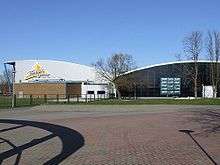
Ventspils has a well developed sports infrastructure. One of the most popular sporting facility in Ventspils is the Olympic Centre 'Ventspils' offering a basketball hall, ice hall, track-and-field arena, and football stadiums. One can also enjoy the Water Adventure Park,Seaside Aqua-Park, and Adventure Park that turns into a Skiing Hill 'Lemberga hūte during the winter.
The city has a basketball team that has won the Latvian championship in the last several years. In the 2001/2002 season, the team took third place in the North European Basketball League (NEBL). Ventspils also has a football team in FK Ventspils who compete in the Virsliga. In the 2006 season the team has won the Latvian championship for the first time.
Tourism
Ventspils has a 600 mm (1 ft 11 5⁄8 in) narrow gauge train; a beach and dunes and an observatory with a telescope and digital planetarium.
Old Town of Ventspils

Ventspils developed rapidly as a commercial harbour in the years of growth of Duchy of Courland and Semigallia. The most active building works took place in the vicinity of the present Market Square where a number of former storehouses from the 17th century are preserved. A dwelling house at the crossing of Tirgus and Skolas Streets is one of the oldest houses of such type in Latvia (built in 1646).
Next to the Market Square, in a historical school building on Skolas street, there is the Ventspils House of the Crafts (2007). The International Writers’ and Translators’ House (2006) was opened on the premises of the former City Hall (1850), on the City-Hall Square. The building is reconstructed to accommodate creative work and everyday needs of its writers. Located next to it are the recently renovated Ventspils Central Library (2006) and Evangelic-Lutheran Church of Nicholas (1835). The City-Hall Square, the Market Square and the Ostas Street Promenade are popular walking places.
Cow sculptures

CowParade in Ventspils took place in 2002, and now several cow sculptures reside in the city:
- ‘Latvijas melnā’ (Latvian Black Cow) dwells on the Promenade of Ostas iela;
- ‘Pretim gaismai’ (Towards the Light) that usually climbs the lamp post on Pils iela next to ‘Latvenergo’ JSC;
- ‘Ms. Moo-Dunk’ the basketball cow resides near the Basketball Hall of the Olympic Centre ‘Ventspils’;
- ‘Dzīve ir skaista’ (Life is Beautiful) is situated at the Children’s Park ‘Bērnu pilsētiņa’ (Children’s Town);
- ‘Jūras govs’ (Cow of the Sea) dwells next to the Livonian Order Castle facing the River Venta;
- ‘Nafta’ (Oil) lives next to the Children’s Home ‘Selga’;
- ‘Londonas govs’ (London Cow) welcomes the residents of the camping site ‘Piejūras kempings’.
There are also three considerably larger cows:
- ‘Ceļojošā govs’ (Travelling Cow) is shaped like a huge suit-case and awaits the city guests on the Promenade of Ostas iela to take some pictures;
- ‘Govs-Matrozis’ (The Sailor Cow) is a giant blue-coloured cow dressed as a seafarer and situated at the Southern Pier of Ventspils;
- ‘Šūpojošā govs’ (Cow on the Swings) is a large, but cute and girly cow sitting on the swings not far from the excursion boat ‘Hercogs Jēkabs’.
Notable people
- Fred Rebell (1886–1968) – single-handed sailor
- Dorothy Dworkin (1889-1976) – nurse, businesswoman, and philanthropist.
- Fricis Kaņeps (1916–1981) – footballer
- Francis Rudolph (1921–2005) – painter
- Imant Raminsh (1943) – composer
- Dzintars Ābiķis (1952) – politician
- Ģirts Valdis Kristovskis (1962) – politician
- Sandis Prūsis (1965) – bobsleigh pilot
- Gundars Vētra (1967) – basketball star
- Ēriks Rags (1975) – javelin thrower
- Gatis Gūts (1976) – bobsleigh pilot
- Ingus Janevics (1986) – speedwalker
Twin towns and cities[4]
See also
References
- ↑ "Latvijas iedzīvotāju skaits pašvaldībās 01.01.2012. (PDF)" (PDF). PMLP.gov.lv. Retrieved April 28, 2012. (Latvian)
- ↑ "papildināts (17:24) - Gaisa temperatūra Latvijā pirmo reizi pārsniegusi +37 grādus". Diena.lv. 4 August 2014. Retrieved 4 August 2014. (Latvian)
- ↑ "Unveiling of a new city environment object "Cow Sailor"". 7 July 2006. Retrieved 13 January 2010.
- ↑ Twin cities Ventspils Town Council's homepage
External links
| Wikivoyage has a travel guide for Ventspils. |
| Wikimedia Commons has media related to Ventspils. |


